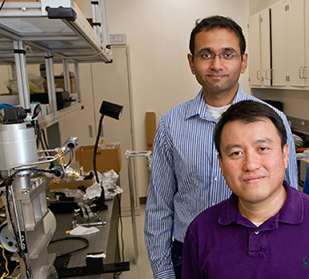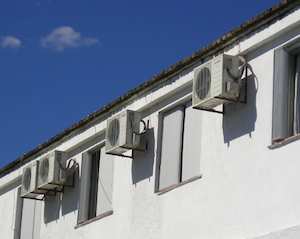 Homes and buildings chilled without air conditioners. Car interiors that don’t heat up in the summer sun. Tapping the frigid expanses of outer space to cool the planet. Science fiction, you say? Well, not any more.
Homes and buildings chilled without air conditioners. Car interiors that don’t heat up in the summer sun. Tapping the frigid expanses of outer space to cool the planet. Science fiction, you say? Well, not any more.
A Stanford team has designed an entirely new form of cooling panel that chills even with the sun at high noon. Such a panel could vastly improve the daylight cooling of buildings, cars and other structures by reflecting sunlight back into the chilly vacuum of space.
“People usually see space as a source of heat from the sun, but away from the sun outer space is really a cold, cold place,” explained Shanhui Fan, a professor of electrical engineering and the paper’s senior author. “We’ve developed a new type of structure that reflects the vast majority of sunlight, while at the same time it sends heat into that coldness, which cools manmade structures even in the daytime.”
The second challenge is that the structure must efficiently radiate heat (from a building, for example) back into space without that radiation interacting with Earth’s atmosphere and causing greenhouse gases. The new structure accomplishes both goals.
The Stanford team has taken a very different approach compared to previous efforts in this field, succeeding where others have come up short by turning to nanostructured photonic materials, which can be engineered to enhance or suppress light reflection in the key frequency range necessary to escape Earth’s atmosphere.
“No one had yet been able to surmount the challenges of daytime radiative cooling –of cooling when the sun is shining,” said Eden Rephaeli, a doctoral candidate in Fan’s lab and a co-first-author of the paper. “It’s a big hurdle.”
 Replacing Air Conditioners
Replacing Air Conditioners
A typical one-story, single-family house with just 10 percent of its roof covered by radiative cooling panels could offset 35 percent its entire air conditioning needs during the hottest hours of the summer.
Radiative cooling has another profound advantage over other cooling equipment, such as air conditioners. It is a passive technology. It requires no energy. It has no moving parts. It is easy to maintain. You put it on the roof or the sides of buildings and it starts working immediately.
Beyond the commercial implications, Fan and his collaborators foresee a broad potential social impact. Much of the human population on Earth lives in sun-drenched regions huddled around the equator. Electrical demand to drive air conditioners is skyrocketing in these places, presenting an economic and environmental challenge. These areas tend to be poor and the power necessary to drive cooling usually means fossil-fuel power plants that compound the greenhouse gas problem.
(SOURCE: Stanford News)



















